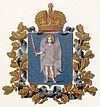1796–1923 → Established November 30, 1796 Political subdivisions uyezds 12 | Disestablished 1923 Today part of Ukraine | |
 | ||
Kiev governorate 1708 1775 top 13 facts
Kiev Governorate was an administrative division of the Russian Empire and Ukraine in 1796 until the Soviet administrative reform of the 1920s. It was considered to be a Little Russian (Ukrainian) governorate due to majority of population speaking in Little Russian dialect (Ukrainian language).
Contents
- Kiev governorate 1708 1775 top 13 facts
- History
- Principal cities
- After 1917
- List of okruhas
- Russian Empire
- Russian Republic
- Ukrainian State
- South Russia
- Soviet governors
- References
History
The Kiev Governorate on the right bank of Dnieper was officially established by Emperor Paul I's edict of November 30, 1796. However it was not until 1800 when there was appointed the first governor and the territory was governed by the Kiev Viceroy Vasiliy Krasno-Milashevich (in 1796-1800).
Three existing Left-bank Ukraine viceroyalties were merged into one Little Russia Governorate centered on Chernigov, while the Kiev Governorate was now comprised on Right-bank Ukraine. With Kiev still a capital, the governorate included the right-bank parts of the former Kiev Viceroyalty merged with territories of the former Kiev and Bracław Voivodeships which were gained by the Russian Empire from the partitions of the Polish-Lithuanian Commonwealth (the lands of the Polish Crown province). The edict took effect on August 29, 1797, bringing the total number of uyezds to twelve.
On January 22, 1832, the Kiev Governorate, along with the Volhynia and the Podolia Governorates formed the Kiev Governorate General, also known as the Southwestern Krai. At the time, Vasily Levashov was appointed the Military Governor of Kiev as well as the General Governor of Podolia and Volhynia. In 1845, the population of the Governorate was 1,704,661.
At the turn of the 20th century, the governorate included twelve uyezds named by their centers: Berdychiv, Cherkasy, Chyhyryn, Kaniv, Kiev, Lipovets, Radomyshl, Skvyra, Tarashcha, Uman, Vasylkiv and Zvenyhorodka.
By the 1897 Russian Census, there were 3,559,229 people in the guberniya making it the most populous one in the whole Russian Empire. Most of population was rural. There were 459,253 people living in cities, including about 248,000 in Kiev. According to the mother tongue, the census classified the respondents as follows: 2,819,145 Little Russians (the Russian government term for Ukrainians) representing 79.2% of the population, 430,489 Jews representing 12.1% of the population, 209,427 Great Russians (the Russian government's term for Russians) representing 5.9% of the population, and 68,791 Poles representing 1.9% of the population. By faith, 2,983,736 census respondents were Orthodox Christians, 433,728 were Jews and 106,733 were of the Roman Catholic Church.
Kiev Governorate remained a constituent unit of the larger Governorate General with Kiev being the capital of both well into the 20th century. In 1915, the General Governorate was disbanded while the guberniya continued to exist.
Principal cities
Russian Empire Census of 1897
After 1917
In the times after the Russian revolution in 1917–1921, the lands of Kiev Governorate switched hands many times. After the last Imperial governor, Alexey Ignatyev until March 6, 1917, the local leaders were appointed by competing authorities. At times, the Governorate Starosta (appointed by the Central Rada) and the Governorate Commissar (sometimes underground) both claimed the Governorate, while some of the short-lived ruling regimes of the territory did not establish any particular administrative subdivision.
As chaos gave way to stability in the early 1920s, the Soviet Ukrainian authority re-established the Governorate whose leading post was titled the Chairman of the Governorate's Revolutionary Committee (revkom) or of the Executive Committee (ispolkom).
In the course of the Soviet administrative reform of 1923–1929 the Kiev Guberniya was transformed into six okruhas in 1923, and, since 1932, Kiev Oblast at the territory.
List of okruhas
Russian Empire
Russian Republic
as Governing Commissioners
Ukrainian State
as Governing Elders
